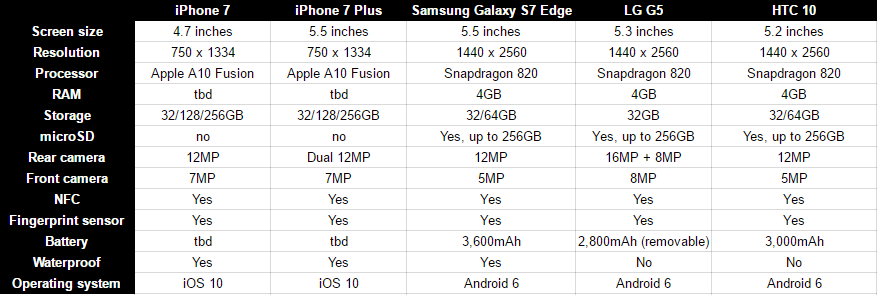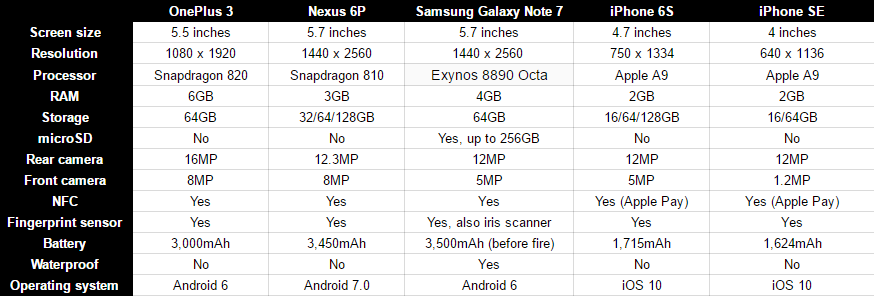Apple just officially unveiled the iPhone 7 and 7 Plus on stage, and while there’s lots of questions left to be answered, we do at least know the specs. That can tell us a lot about a device, so how do Apple’s new babies stack up to the very best Android competition, and Apple’s cheaper iPhones?
DON’T MISS: The new iPhone 7: waterproof, all black, and no headphone port in sight

There’s not too many surprises here. Apple has never fought the specs wars very hard, so on paper, the latest Android phones have the iPhone 7 beat. 4GB of RAM is the standard on newer phones, with some even going up to 6GB. Apple doesn’t disclose RAM figures, but teardowns when the device goes on sale will likely show 3GB of RAM for the base iPhone 7.

Screen size and pixel density also sees Apple lose out. The 4.7-inch iPhone 7 is smaller than all the Android flagships, and even the giant iPhone 7 Plus is barely what would be considered a “phablet.” Part of that is down to physical size: the iPhones are larger, relative to their screen size, than the Android counterparts. That means more room for battery, but also makes it harder for people with small hands to grasp.
While we’re talking about screens, we should also mention resolution for a second. The best Android phones like the Galaxy S7 Edge, LG G4 and HTC 10 all have the same resolution, 1440 x 2560. By comparison, the iPhone’s 750 x 1334 looks a little dated on paper. In the flesh, iPhones have always been just fine for resolution: ever since the iPhone 4 came along with the first Retina screen, it’s been difficult to find pixels on iPhone displays. You have to dig a little deeper than resolution to find the real differences.
Apple has stuck with the tried-and-tested IPS screen technology for the iPhone 7. Apple has experience with the panels, and it manages to wring crisp colors and good battery life out of the aging technology. We’ll have to wait for side-by-side comparisons to the Android phones, but Apple claims to have made big improvements this year, with better colors and 25% brighter.
The iPhone 7 is also the first waterproof iPhone ever. Apple’s achieved an IP67 rating, which means total protection against dust, and resistance to 1 meter of water for 30 minutes. It’s a little worse than the IP68 rating Samsung claims for the Samsung Galaxy S7, but should be functionally similar for everyone who doesn’t swim with their phones.
Other specs aren’t such a surprise. Apple has never had a device with a microSD card slot, and no iPhone has ever had a removable battery. Some Android devices are starting to follow that pattern, with the OnePlus 3 and Nexus 6P notably omitting the microSD slot. Only the LG G5 has a removable battery, unless you count the Galaxy Note 7’s exploding battery as “removable.”
All in all, the specs paint a familiar story for Apple. The iPhone 7 and 7 Plus look like they’re just good enough on paper, with screens, batteries and chipsets that are within touching distance of the best Android devices. But the difference comes with the execution, and Apple has a long history of embarrassing the better-equipped devices in the real world. The new A10 Fusion chip sounds scarily fast and efficient, with claimed console-level gaming on a handset.










